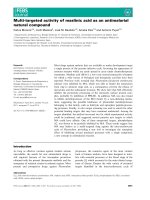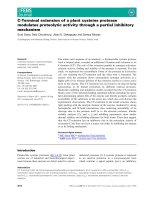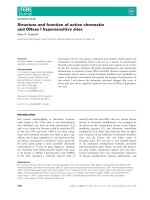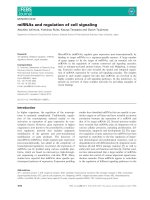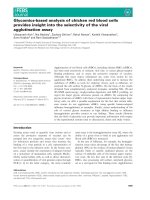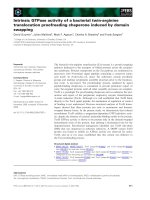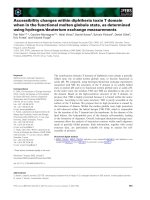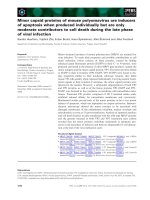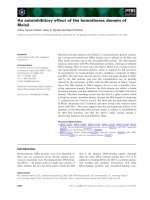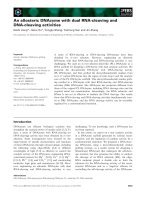Tài liệu Báo cáo khoa học: Substrate specificity of the pseudouridine synthase RluD in Escherichia coli doc
Bạn đang xem bản rút gọn của tài liệu. Xem và tải ngay bản đầy đủ của tài liệu tại đây (363.6 KB, 8 trang )
Substrate specificity of the pseudouridine synthase RluD
in Escherichia coli
Margus Leppik, Lauri Peil, Kalle Kipper, Aivar Liiv and Jaanus Remme
Institute of Molecular and Cell Biology, Tartu University, Tartu, Estonia
Pseudouridines (Y) are the most common modifications
in stable RNAs. Pseudouridine was discovered as a fifth
nucleotide in yeast tRNA 50 years ago [1]. Pseudo-
uridines are synthesized from uridine by pseudouridine
synthases, a reaction that does not need additional
cofactors or external energy sources. Pseudouridine
synthases are classified into five families according to
their amino acid sequence [2,3]. Despite low sequence
homology of the enzymes, structural comparison of
crystal structures reveals that all pseudouridine synth-
ases share a core with a common fold and a conserved
active site cleft [4].
Pseudouridines are found in all tRNAs and high-
molecular rRNAs. 16S ribosomal RNA from Escheri-
chia coli contains one pseudouridine Y516 formed by
RsuA [5]. 23S rRNA from E. coli contains ten Y resi-
dues, which are made by six enzymes RluA–RluF [6].
Enzymes such as RsuA and RluB isomerize only one
uridine in the substrate RNA whereas others (RluC
and RluD) make three pseudouridines [7–9]. RluA
modifies uridine 746 in 23S rRNA and uridine 32 in
some specific tRNA species [10].
RluD isomerizes uridines at positions 1911, 1915,
and 1917 in stem-loop 69 (H69) of 23S rRNA [8,9].
Y1917 is found at the corresponding position of the
large ribosomal subunit RNAs throughout all king-
doms. It is the most conserved modification in
rRNA [6]. Y1915 is also highly conserved [6]. Y1915
is methylated at N3 in several eubacteria [11]. Y1911
is also well conserved, except in archaea [6]. Y to C
mutation at position 1917 has a dramatic effect on
the ribosome functioning, which is explained by the
universal nature of Y1917 [12]. H69 of 23S rRNA
directly interacts with tRNA at the A and P site
[13,14]. H69 forms the intersubunit bridge 2 with
helix 44 of 16S rRNA [15,16]. Y1917 forms a reverse
Hoogsteen base pair with A1912, which in turn
forms A-minor interaction with base pairs C1407–
G1494 of 16S rRNA [16]. Pseudouridine residues can
stabilize the 3D RNA structure as revealed by
Keywords
23S rRNA; helix 69; pseudouridine;
ribosome assembly; RluD
Correspondence
J. Remme, Riia 23, 51010 Tartu, Estonia
Fax: +372 42 0286
Tel: +372 73 75031
E-mail:
(Received 24 May 2007, revised 6 Septem-
ber 2007, accepted 10 September 2007)
doi:10.1111/j.1742-4658.2007.06101.x
Pseudouridine synthase RluD converts uridines at positions 1911, 1915,
and 1917 of 23S rRNA to pseudouridines. These nucleotides are located in
the functionally important helix-loop 69 of 23S rRNA. RluD is the only
pseudouridine synthase that is required for normal growth in Escherichia
coli. We have analyzed substrate specificity of RluD in vivo. Mutational
analyses have revealed: (a) RluD isomerizes uridine in vivo only at posi-
tions 1911, 1915, and 1917, regardless of the presence of uridine at other
positions in the loop of helix 69 of 23S rRNA variants; (b) substitution of
one U by C has no effect on the conversion of others (i.e. formation of
pseudouridines at positions 1911, 1915, and 1917 are independent of each
other); (c) A1916 is the only position in the loop of helix 69, where muta-
tions affect the RluD specific pseudouridine formation. Pseudouridines
were determined in the ribosomal particles from a ribosomal large subunit
defective strain (RNA helicase DeaD
–
). An absence of pseudouridines in
the assembly precursor particles suggests that RluD directed isomerization
of uridines occurs as a late step during the assembly of the large ribosomal
subunit.
Abbreviations
Y, pseudouridine; ASL, anticodon stem loop; H69, stem-loop 69.
FEBS Journal 274 (2007) 5759–5766 ª 2007 The Authors Journal compilation ª 2007 FEBS 5759
thermodynamic studies on the isolated helix-loop 69
[17].
Deletion of the yfiI(rluD) gene reduces the growth
rate by three- to five-fold [8,9] and leads to accumula-
tion of the precursor particles for the large and small
subunits [18]. Ribosomes lacking RluD specific
pseudouridines are less stable at low magnesium ion
concentration and exhibit reduced activity during
poly(U) translation in vitro [19]. These effects were
attributed to the lack of pseudouridines in H69 [19].
However, in the presence of an as yet unidentified sec-
ond site mutation, bacteria lacking RluD are able to
grow at a similar rate as wild-type cells. This pseudo-
revertant strain does not contain Y in H69 and exhib-
its normal ribosome assembly [19, L. Peil & J. Remme,
unpublished data]. The exact role of pseudouridines in
H69 for the function of ribosomes remains unclear.
Grosjean and coworkers have highlighted two
important questions concerning tRNA-modifying
enzymes: (a) at which stage of the complex maturation
process does the modification of a given nucleoside
occur and (b) how does the corresponding enzyme rec-
ognize the target site within the tRNA architecture
[20]? Similar questions on the rRNA-modifying
enzymes remain unanswered for nearly all rRNA-mod-
ifying enzymes, including RluD.
RluD belongs to the RluA family [2]. Binding of
RluA to one of its substrates, tRNA
Phe
anticodon
stem-loop, induces reorganization of the RNA [21]. An
ability of the RNA substrate to adopt the alternative
fold with a reverse Hoogsteen base pair is used by
RluA to recognize its substrate [21]. It is possible that
such indirect sequence readout is used also by other
members of the RluA family (e.g. RluD). Under cell-
free conditions and in vitro, transcribed rRNA RluD
has low substrate specificity, converting one out of 20
uridine residues in 23S rRNA and one out of eight uri-
dine residues in 16S rRNA to pseudouridine [9].
We have analyzed the substrate specificity of the
pseudouridine synthase RluD in vivo by using 23S
rRNA variants. Single point mutations were intro-
duced to the plasmid copy of the 23S rRNA gene. 23S
rRNA variants were expressed in vivo and purified by
affinity tag. Pseudouridines around helix-loop 69 were
determined by chemical modification.
Results
RluD synthesizes
Y
only at U1911, U1915, and
U1917
Helix-loop 69 of E. coli 23S rRNA contains uridine at
positions 1911, 1915, and 1917, which are all converted
to pseudouridines by the pseudouridine synthase RluD
(Fig. 1). To test whether or not RluD is able to modify
uridine at other positions of the H69, nucleotides
A1912, C1914, A1916, and A1919 were substituted by
uridine as single point mutations. Mutant genes were
expressed in vivo and the mutant ribosomal particles
were isolated as described in the Experimental proce-
dures. All 23S rRNA variants were incorporated into
fractions 50S and 70S. Pseudouridines were determined
by chemical modification, followed by reverse trans-
criptase directed primer extension. The primer exten-
sion stop on the CMCT treated RNA (+ lane)
indicated the presence of pseudouridine at the particu-
lar position when the stop was not present in the con-
trol (– lane). m
3
Y present at position 1915 [11] causes
primer extension stop independent of CMCT treatment
(Fig. 2). It must be noted that m
3
Y can form a Wat-
son–Crick base pair in a syn conformation of glycoside
bond, allowing low level readthrough by reverse trans-
criptase. Therefore, it was not possible to identify
pseudouridylation at position 1915. rRNA isolated
from an E. coli strain lacking a gene for RluD was
used as a control.
Primer extension patterns of the wild-type 23S
rRNA from the 50S and the 70S particles were similar:
stop sites were found at positions 1911 and 1917 on
the CMCT treated RNA and not on the control RNA
(wild-type 70S and wild-type 50S; Fig. 2). This shows
that pseudouridines were present at positions 1911 and
1917 in the wild-type 23S rRNA in the 50S subunits
and in the 70S ribosomes. 23S rRNA from a strain
lacking RluD did not have pseudouridines in H69 as
Fig. 1. A scheme of E. coli 23S rRNA stem-loop 69 (H69). Numbers
of the pseudouridine residues and m
3
Y are indicated according to
standard E. coli 23S rRNA numeration.
RluD specificity in vivo M. Leppik et al.
5760 FEBS Journal 274 (2007) 5759–5766 ª 2007 The Authors Journal compilation ª 2007 FEBS
expected (RluD
–
; Fig. 2). 23S rRNA variants A1912U
(70S), C1914U (70S and 50S), and A1919U (70S, 50S)
exhibited the same CMCT ⁄ alkali induced primer
extension stop site pattern as wild-type 23S rRNA
(Fig. 2), indicating that pseudouridines were present at
the wild-type positions (1911 and 1917) and not at
mutant positions. The 23S rRNA variant A1916U
derived from free 50S subunits did not exhibit pseudo-
uridine specific stop sites at positions U1911, U1916,
and U1917 (Fig. 2). Thus, pseudouridine was not
detected in H69 of the 23S rRNA variant A1916U iso-
lated from free 50S subunits. In the 70S particles, the
CMCT induced stop sites were just on the border of
detection limit, indicating that only traces of pseudo-
uridines were present (Fig. 2). This result suggests that
A1916 is an important specificity determinant for
RluD. Pseudouridines were found at wild-type posi-
tions (1911 and 1917) in spite of the presence of uri-
dine at other positions. We conclude that RluD is
specifically recruited to positions U1911 and U1917 of
E. coli 23S rRNA, at least in vivo.
Mutations at position A1916 affect the specificity
of RluD
Substitution of uridine by cytidine at position 1911
leads to the disappearance of a CMCT dependent stop
signal at position 1911 as expected (Fig. 3). Similar
results were obtained with the transition at posi-
tions 1915 and 1917. These mutations had an effect on
the formation of pseudouridine exclusively at the
mutant position and did not affect either of the other
two positions (Fig. 3). Y1917 was also found in the
23S rRNA variant containing the double mutation
U1911C ⁄ U1915C (Fig. 3). Thus, isomerization of uri-
dines 1911 and 1917 in H69 occurs autonomously of
each other and is independent of modification at 1915.
Additional 23S rRNA variants were analyzed
regarding RluD specificity. Mutations A1912C,
A1913G, C1914A, A1916C, A1918G and A1919G
showed either no or very little effect on the RluD spe-
cific pseudouridine formation at positions 1911 and
1917 (Fig. 4). It must be noted that the band corre-
sponding to the Y1911 of the variants A1913G and
A1918G is very weak due to strong stop sites at 1917
and 1915 (Fig. 4). Longer exposure revealed the pres-
ence of a Y specific band at position 1911 (not shown).
The transversion A1916U reduced pseudouridine for-
mation to undetectable level in 50S subunits and
caused strong reduction in 70S ribosomes by RluD as
described above. (Fig. 2). Y residues at positions 1911
and 1917 were found in 70S ribosomes when A1916
was substituted by G, albeit at a reduced level. By
contrast, Y residues at positions 1911 and 1917 did
not show up in 23S rRNA extracted from free 50S
Fig. 2. Primer extension analysis of the pseudouridines in the helix-loop 69 of 23S rRNA. 23S rRNA variants were expressed in vivo, 70S
ribosomes and free 50S subunits containing mutant RNA were isolated. +, CMCT ⁄ alkali treatment; –, untreated RNA. Bands corresponding
to the 23S rRNA positions 1911, 1915, and 1917 are indicated. DNA sequencing lanes are shown on the right. Note that CMCT induced stop
site is one nucleotide below the actual modification.
Fig. 3. Pseudouridine sequencing analysis of 23S rRNA variants.
Effect of substitution of uridine on the RluD activity. For details,
see Fig. 1 and Experimental Procedures.
M. Leppik et al. RluD specificity in vivo
FEBS Journal 274 (2007) 5759–5766 ª 2007 The Authors Journal compilation ª 2007 FEBS 5761
subunits (Fig. 4). The presence of pseudouridines in
70S but not in free 50S subunits can be explained by
reduced rates of pseudouridine formation due to the
transition of A1916 to G. The effects of the mutations
in 23S rRNA on the pseudouridine formation in H69
are summarized in Table 1. It is evident that only
mutations at position A1916 to G and U affect RluD
activity. A weak stop site at position 1915 was detected
in CMCT untreated samples of 23S rRNA variants
A1916U and A1916G (only 50S fraction), suggesting a
low level of N
3
methylation of uridine.
RluD modification occurs during late assembly
We have analyzed whether RluD forms pseudouridines
during early assembly on naked 23S rRNA or alterna-
tively requires the presence of r-proteins for its activ-
ity. We used an E. coli strain (deaD
–
), negative for the
RNA helicase DeaD (CsdA), which has been shown to
be deficient in ribosomal large subunit assembly [22].
40S particles accumulating in this strain are assembly
precursors of 50S subunits (L. Peil & J. Remme,
unpublished results). We have analyzed 23S rRNA
from 40S, 50S and 70S particles regarding Y residues
in H69 of 23S rRNA. Primer extension analysis
showed that, in the wild-type strain, both 70S and 50S
particles contain RluD specific pseudouridines. 70S
ribosomes from the deaD
–
strain contain Y residues at
positions 1911 and 1917, indicating that RluD is active
in the absence of DeaD. 23S rRNA in the 40S and
50S particles shows only traces of RluD specific Y
residues (Fig. 5). 50S particles of the deaD
–
strain
have low functional activity, probably due to incom-
plete assembly (L. Peil & J. Remme, unpublished
Fig. 4. Effect of single point mutations in the helix-loop 69 on the RluD directed pseudouridine synthesis. For details, see Fig. 1 and Experi-
mental Procedures.
Table 1. Conversion of uridine at positions 1911 and 1917 to
pseudouridine on 23S rRNA variants in the 50S subunits and 70S
ribosomes in vivo. Presence of a pseudouridine residue on the 23S
rRNA variant is shown by +; absence of pseudouridine residue is
shown by a ). ND, not determined.
Mutant
70S 50S
1911 1917 1911 1917
U1911C – + – +
A1912U + + ND ND
A1912C + + ND ND
A1913G + + + +
C1914U + + + +
C1914A + + + +
U1915C + + + +
A1916G + + – –
A1916C + + + +
A1916U – – – –
U1917C + – + –
A1918G + + + +
A1919G + + ND ND
A1919U + + ND ND
Fig. 5. Identification of pseudouridines in the helix-loop 69 in differ-
ent stages of 50S biogenesis by primer extension. Ribosomal parti-
cles were isolated from wild-type and the deaD
–
strain. 40S
particles are assembly precursors accumulating in the deaD
–
strain.
RluD specificity in vivo M. Leppik et al.
5762 FEBS Journal 274 (2007) 5759–5766 ª 2007 The Authors Journal compilation ª 2007 FEBS
results). We conclude that RluD directed isomerisarion
of uridines in the helix-loop 69 of 23S rRNA occurs as
a late event during assembly of the ribosomal large
subunit, but before the 50S subunit enters the 70S
pool.
Discussion
Each pseudouridine in eubacterial rRNA is formed by
a single pseudouridine synthase [6]. On the other hand,
some pseudouridine synthases are able to isomerize
several uridines (e.g. RluC and RluD isomerize three
uridines each). It was proposed that RluD recognizes
all uridines in or near the loop of helix 69 and con-
verts them to pseudouridines [6]. This type of regional
specificity was recently found to be used by TruA
which converts any uridine at positions 38–40 of sub-
strate tRNA to pseudouridine [23]. We have tested
whether or not RluD has similar regional specificity by
mutating nucleotides at positions A1912, A1913,
C1914, A1916, and A1919 of H69 to uridine. None of
the mutant uridines was converted to pseudouridine
in vivo. This result demonstrates that the pseudouridine
synthase RluD is specific to positions 1911 and 1917
and its specificity is not of regional type. Thus, in vivo,
RluD is highly specific to positions where pseudouri-
dine is found in a wide range of species. By contrast,
RluD was reported to exhibit low substrate specificity
in vitro [9]. RluD converted 40 uridines to pseudouri-
dines in in vitro transcribed 16S and 30 uridines in the
23S rRNA transcript [9]. In vitro transcribed rRNA is
not correctly folded, which can be one reason for the
low specificity.
Substitution of U by C revealed formation of
pseudouridines at positions 1911 and 1917 auto-
nomous of each other and independent of Y1915 for-
mation. Moreover, Y1917 was formed on the double
mutant 23S rRNA (U1911C ⁄ A1915C). Mutations in
H69 exhibited similar effects on the Y synthesis at
positions 1911 and ⁄ or 1917, suggesting that both
have the same identity determinants. The most
important position for determining RluD specificity
was found to be nucleotide A1916. A and C are per-
missive nucleotides. Both nucleotides are found in
bacterial 23S rRNA sequences. U has the strongest
and G has intermediate negative effect on the RluD
activity. Suzuki and colleagues have selected 20 viable
sequence variants of H69 [24]. The presence of
pseudouridines was determined for a subset of vari-
ants. Mutations U1915A and A1916C did not affect
pseudouridinylation of U1911 and U1917 [24], in
agreement with the results described in the present
study.
Mutation A1916 to G and U had severe effects on
RluD in vivo. Y1911 and Y1917 were found on the
23S rRNA variants in the 70S ribosomes, albeit at a
reduced level, but not in the 50S fraction. Substitution
of A1916 by U had stronger effect on the RluD com-
pared to A1916G mutation. Thus, the nucleotide
A1916 in 23S rRNA is an important identity element
for pseudouridine synthesis at both positions 1911 and
1917. This indicates that the identity determinants are
at least partially overlapping for both positions.
Although RluD is highly specific to positions 1911 and
1917, this enzyme is insensitive to the base substitu-
tions in the loop of helix 69. This apparent contradic-
tion can be resolved assuming that A1916 is important
for the initial docking of the RluD. Identity determi-
nants required for the pseudouridine formation may lie
within the flipped out conformation of H69 because
base flipping is obligatory for Y synthesis [4].
The cocrystal structure of E. coli TruB bound to the
T-stem and loop fragment of tRNA has been deter-
mined [25]. This structure suggests that TruB recog-
nizes the T-loop by shape and makes sequence specific
contacts with a few invariant nucleotides, such as C56
[25]. Genetic and biochemical data have shown that
isomerization of U55 in tRNA by E. coli TruB or by
its yeast (Saccharomyces cerevisiae) ortholog PUS4 is
sensitive to base substitution in the TY-loop [20,26]. A
second cocrystal structure of pseudouridine synthase
and its substrate was recently determined for RluA
and the anticodon stem loop (ASL) of tRNA [21]. This
enzyme gains specificity by inducing a conformational
change in the substrate RNA. This structure involves a
reverse Hoogsteen base pair (U33:A36) and base flip-
ping of three bases including the substrate uridine 32.
These structural elements are absent in normal tRNA.
RluA appears to recognize its substrate by indirect
readout of a protein induced RNA structure [21]. It is
therefore interesting to note that hairpin 35 of the 23S
rRNA (another substrate for RluA) has a structure in
its isolated state similar to ASL of free tRNA [27].
With three flipped out bases, hairpin 35 in the ribo-
some has completely different structure [16]. It has
some similarity to the conformation of ASL in com-
plex with RluA. It is possible that RluA supports
refolding hairpin 35 during ribosome assembly. RluD
belongs to the RluA family and the catalytic cores of
both proteins show similar folds [4]. H69 of 23S rRNA
is known to adopt different conformations in 50S and
70S ribosomes. In 70S ribosomes, Y1917 forms a
reverse Hoogsteen type base pair with A1912 which
makes it similar to the ASL in complex with RluA.
Deletion of RluD leads to accumulation of assembly
defective ribosomal subunits [18,19]. It is thus tempting
M. Leppik et al. RluD specificity in vivo
FEBS Journal 274 (2007) 5759–5766 ª 2007 The Authors Journal compilation ª 2007 FEBS 5763
to speculate that RluD may have a role in ribosome
assembly by an RNA chaperone function in the H69
region.
Ribosomal subunit assembly involves folding of
rRNA and r-proteins and association of both into
functional subunits. In addition, post-transcriptional
modifications are made in rRNA and post-transla-
tional modifications added to r-proteins during ribo-
some assembly. Ribosomal 50S subunits are formed
in vivo during 1–2 min after transcription of 23S
rRNA, but an additional 3 min are required before the
large subunits enter the functional 70S pool [28]. This
additional time is probably used for making late
assembly specific modifications of rRNA and r-pro-
teins and for fine adjustment of ribosome structure.
Analysis of the pseudouridylation pattern in ribosome
assembly precursor particles of 23S rRNA has shown
that the pseudouridines in H69 are formed by RluD
during late assembly. RluD can function in ribosome
assembly by helping to refold H69 into a functional
structure. The refolded H69, containing pseudouri-
dines, supports ribosome subunit association. The
results indicating that Y1911 and Y1917 are present in
the 70S ribosomes but not in the 50S subunits on the
23S rRNA variant A1916G are in agreement with the
role of RluD in functional 50S formation. Taken
together, the results suggest that rRNA modification,
in particular by RluD, is an important event during
late assembly of 50S particles.
Experimental procedures
Plasmids and strains
23S rRNA single point mutations were initially constructed
by PCR mutagenesis on plasmid pXB containing the E. coli
23S rRNA gene with streptavidine binding tag [29]. Mutant
23S rRNA variants A1912U, A1912C, A1913G, C1914U,
A1916G, A1916C, A1916U, A1917G, A1919C, and
A19191U were fused to ptBB expression vector in which
the rrnB operon is under control of the tac promoter [12].
23S rRNA variants U1911C, C1914A, U1915C, and
A1918G were recloned into the expression vector pKK
3535.
The deaD
–
strain (deaD414), where the deaD gene was
disrupted by a kanamycin resistance cassette, was gener-
ously provided by Dr Kenneth E. Rudd (University of
Miami, FL, USA). For our experiments, bacteriophage P1
transduction was used to transfer deaD::kan gene into
E. coli strain MG1655 [30].
The E. coli strain MG1655 was used as parental strain to
construct strain rluD::cat (rluD114) according to the
method of Datsenko and Wanner [31]. The cat cassette
from plasmid pKD3 was amplified by PCR using Pwo
polymerase (Roche Diagnostics GmbH, Mannheim, Ger-
many) and primers rluD114::cat(pKD3) 5¢ (5¢-GCT ACA
ATA GCA CAC TAT ATT AAA CGG CAA AGC CGT
AAA ACC CC
G TGT AGG CTG GAG CTG CTT CG-
3¢) and rluD114::cat(pKD3) 3¢ (5¢-GAC CAG ATT AAT
GTG AAA AGA AAA TCA CGC GTA CCG GAT CGT
CTT G
AT GGG AAT TAG CCA TGG TCC-3¢) (comple-
mentary regions to the rluD-flanking regions are under-
lined). The resulting 1123 bp PCR product was gel-purified
using UltraClean 15 DNA Purification kit (MoBio, West
Carlsbad, CA, USA). Twenty nanograms of of purified
PCR product was then electroporated into
MG1655 ⁄ pKD46 competent cells, previously grown in the
presence of 10 mm arabinose and made competent by con-
centrating ten-fold and washing five times with ice-cold
10% glycerol. Selection for the recombination event and
the elimination of pKD46 plasmid was performed as
described previously [31]. Colonies were tested for the rluD
deletion by PCR, using primers flanking the gene, and by
Southern analysis. The rluD::cat strain had a full deletion
of both rluD and yfiH, together with their annotated pro-
moter sequences. The inserted cat cassette had a distance of
90 nt from the b2595 gene and 177 nt from the clpB gene.
Preparation of ribosomes and rRNA
23S rRNA variants A1912U, A1912C, A1913G, C1914U,
A1916G, A1916C, A1916U, A1917G, A1919C, and
A19191U were expressed in the E. coli strain XL1-Blue
transformed with the corresponding ptBBtag plasmid. Cells
were grown at 37 °Cin2· YT medium supplemented with
ampicillin (100 lgÆmL
)1
). Ribosomes were isolated from
cells 2 h after induction with isopropyl thio-b-d-galactoside
(Fermentas, Vilnius, Lithuania) (1 mm) until an attenuance
of 0.2 at D
600
was reached. Other strains were grown in
2 · YT medium until an attenuance of 0.2–0.3 at D
600
was
reached (deaD414 cells were grown at 25 °C). Bacteria were
collected by low-speed centrifugation, resuspended in lysis
buffer and lysed by freeze-thawing as described previously
[12].The lysate was diluted with an equal volume of ice-cold
buffer LLP (10 mm Tris ⁄ HCl (pH 8.0), 60 mm KCl, 60 mm
NH
4
Cl, 12 mm MgOAc, 6 mm b-mercaptoethanol). Two
millilitres of diluted lysate were layered onto a 10–25%
(w ⁄ w) sucrose gradient in buffer LLP and centrifuged for
x
2
t ¼ 2.7 · 10
11
at 4 °C. Gradients were analysed with con-
tinuous monitoring at 254 nm. Fractions containing ribo-
somal particles were collected and stored at )70 °C. 70S
ribosomes and free 50S subunits were isolated by sucrose
gradient centrifugation as described previously [12]. Plasmid
encoded mutant ribosomal large subunits were separated
from wild-type ribosomes according to a previously
described method [29]. 50S or 70S particles were incubated
with streptavidine-Sepharose (GE Helthcare Biosciences
RluD specificity in vivo M. Leppik et al.
5764 FEBS Journal 274 (2007) 5759–5766 ª 2007 The Authors Journal compilation ª 2007 FEBS
AB, Uppsala, Sweden) in buffer [10 mm Tris ⁄ HCl (pH 8.0),
60 mm KCl, 60 mm NH
4
Cl, 1 mm MgOAc, 6 mm b-mer-
captoethanol]. Plasmid encoded ribosomes were eluted in
the same buffer containing 100 m m biotine. Mutant ribo-
somes contained less than 10% wild-type ribosomes accord-
ing to primer extension around the tag site.
23S rRNA variants U1911C, C1914A, U1915C, and
A1918G were expressed in E. coli strain MC315 (Dlac,
DrecA, D7 prrn) [32,33] transformed with pKK3535 deriva-
tives. 70S, 50S, and 30S gradient fractions were collected
and precipitated with 2.5 volumes of ice-cold ethanol.
rRNA was prepared using a modified protocol [12]. In
brief, ribosomes were dissolved in 200 lL of water and
1 mL of PN solution (catalog no. 19071; Qiagen, Hilden,
Germany) was added. Ribosomal proteins were extracted
by vigorous shaking for 20 min at room temperature.
Twenty microlitres of a 50% silica suspension in water was
added and RNA was bound for additional 10 min at room
temperature with gentle mixing. Silica was pelleted by cen-
trifugation at 3000 g for 30 s and washed twice with 70%
ethanol. RNA was eluted with 50 lL of water (10 min at
room temperature).
Determination of pseudouridines
Pseudouridines were determined according to the method
of Ofengand [34]. Fifteen micrograms rRNA were dissolved
in 20 lL of water, 80 lL of BEU buffer (7 m urea, 4 mm
EDTA, 50 mm Bicine ⁄ NaOH pH 8.5) and 20 lLof
CMCT ⁄ BEU buffer (1 m CMCT in BEU buffer) (CMCT;
Sigma-Aldrich Chemie GmbH, Steinheim, Germany) were
added. One hundred microlitres of BEU buffer were added
to 15 lg of rRNA in 20 lL of water serving as negative
control. Both samples were incubated at 37 °C for 20 min
for CMCT modification of U, G and Y residues. After
incubation, 38 lL4m NaOAc were added, followed by
600 lL of cold 96% ethanol. Samples were kept at )20 °C
for 10 min and the RNA precipitate was collected by cen-
trifugation at 6000 g and 4 °C. The supernatant was care-
fully removed and RNA was washed twice with 600 lLof
70% ethanol. The precipitate was dried at 37 °C for
10 min. rRNA was dissolved in 50 lL of NPK buffer
(20 mm NaHCO
3
,30mm Na
2
CO
3
,2mm EDTA) and the
samples were incubated at 37 °C for 4 h to allow removal
of CMCT from U and G residues. After incubation, rRNA
was precipitated and washed as described above. The pre-
cipitate was dissolved in 20 lL of water and stored at
)20 °C. Pseudouridine sequencing of rRNA was carried
out by primer extension using primer U1 (CAG CCT GGC
CAT CAT TAC GCC) and AMV reverse transcriptase
(Seikagaku Corp., Tokyo, Japan) in the presence of
[a-
32
P]dCTP (Amersham Biosciences, Piscataway, NJ,
USA). The resulting DNA fragments were resolved in 7%
polyacrylamide-urea gel. Radioactivity was visualized by
Typhoon phosphor imager (GE Healthcare, Tokyo, Japan).
Acknowledgements
This paper is dedicated to the memory of Professor
James Ofengand from the Univeristy of Miami. We
thank Dr U
¨
. Maiva
¨
li for critically reading the manu-
script and Joachim Gerhold (both from Tartu Univer-
sity) for correcting the English. The research was
supported by Estonian Science Foundation Grants
No. 5822 (JR) and No. Aivar (AL).
References
1 Davis FF & Allen FW (1957) Ribonucleic acids from
yeast which contain a fifth nucleotide. J Biol Chem 227,
907–915.
2 Koonin EV (1996) Pseudouridine synthases: four fami-
lies of enzymes containing a putative uridine-binding
motif also conserved in dUTPases and dCTP deaminas-
es. Nucleic Acids Res 24, 2411–2415.
3 Kaya Y & Ofengand J (2003) A novel unanticipated
type of pseudouridine synthase with homologs in bacte-
ria, archaea, and eukarya. RNA 9, 711–721.
4 Hamma T & Ferre-D’Amare AR (2006) Pseudouridine
synthases. Chem Biol 13, 1125–1135.
5 Wrzesinski J, Bakin A, Nurse K, Lane BG & Ofengand
J (1995) Purification, cloning, and properties of the 16S
RNA pseudouridine 516 synthase from Escherichia coli.
Biochemistry 34, 8904–8913.
6 Ofengand J (2002) Ribosomal RNA pseudouridines and
pseudouridine synthases. FEBS Lett 514, 17–25.
7 Conrad J, Sun D, Englund N & Ofengand J (1998) The
rluC gene of Escherichia coli codes for a pseudouridine
synthase that is solely responsible for synthesis of
pseudouridine at positions 955, 2504, and 2580 in 23 S
ribosomal RNA. J Biol Chem 273, 18562–18566.
8 Raychaudhuri S, Conrad J, Hall BG & Ofengand J
(1998) A pseudouridine synthase required for the forma-
tion of two universally conserved pseudouridines in
ribosomal RNA is essential for normal growth of
Escherichia coli. RNA 4, 1407–1417.
9 Huang L, Ku J, Pookanjanatavip M, Gu X, Wang D,
Greene PJ & Santi DV (1998) Identification of two
Escherichia coli pseudouridine synthases that show
multisite specificity for 23S RNA. Biochemistry 37,
15951–15957.
10 Wrzesinski J, Nurse K, Bakin A, Lane BG & Ofengand
J (1995) A dual-specificity pseudouridine synthase: an
Escherichia coli synthase purified and cloned on the
basis of its specificity for psi 746 in 23S RNA is also
specific for psi 32 in tRNA (phe). RNA 1, 437–448.
11 Kowalak JA, Bruenger E, Hashizume T, Peltier JM,
Ofengand J & McCloskey JA (1996) Structural charac-
terization of U*-1915 in domain IV from Escherichia
coli 23S ribosomal RNA as 3-methylpseudouridine.
Nucleic Acids Res 24, 688–693.
M. Leppik et al. RluD specificity in vivo
FEBS Journal 274 (2007) 5759–5766 ª 2007 The Authors Journal compilation ª 2007 FEBS 5765
12 Liiv A, Karitkina D, Maivali U & Remme J (2005)
Analysis of the function of E. coli 23S rRNA helix-loop
69 by mutagenesis. BMC Mol Biol 6, 18.
13 Korostelev A, Trakhanov S, Laurberg M & Noller HF
(2006) Crystal structure of a 70S ribosome-tRNA com-
plex reveals functional interactions and rearrangements.
Cell 126, 1065–1077.
14 Selmer M, Dunham CM, Murphy F, Vt Weixlbaumer
A, Petry S, Kelley AC, Weir JR & Ramakrishnan V
(2006) Structure of the 70S ribosome complexed with
mRNA and tRNA. Science 313, 1935–1942.
15 Yusupov MM, Yusupova GZ, Baucom A, Lieberman
K, Earnest TN, Cate JH & Noller HF (2001) Crystal
structure of the ribosome at 5.5 A resolution. Science
292, 883–896.
16 Schuwirth BS, Borovinskaya MA, Hau CW, Zhang W,
Vila-Sanjurjo A, Holton JM & Cate JH (2005) Struc-
tures of the bacterial ribosome at 3.5 A resolution.
Science 310, 827–834.
17 Sumita M, Desaulniers JP, Chang YC, Chui HM, Clos
L & Chow CS (2005) Effects of nucleotide substitution
and modification on the stability and structure of helix
69 from 28S rRNA. RNA 11, 1420–1429.
18 Ofengand J, Malhotra A, Remme J, Gutgsell NS, Del
Campo M, Jean-Charles S, Peil L & Kaya Y (2001)
Pseudouridines and pseudouridine synthases of the
ribosome. Cold Spring Harb Symp Quant Biol 66,
147–159.
19 Gutgsell NS, Deutscher MP & Ofengand J (2005) The
pseudouridine synthase RluD is required for normal
ribosome assembly and function in Escherichia coli.
RNA 11, 1141–1152.
20 Becker HF, Motorin Y, Sissler M, Florentz C & Gros-
jean H (1997) Major identity determinants for enzy-
matic formation of ribothymidine and pseudouridine in
the T psi-loop of yeast tRNAs. J Mol Biol 274, 505–
518.
21 Hoang C, Chen J, Vizthum CA, Kandel JM, Hamilton
CS, Mueller EG & Ferre-D’Amare AR (2006) Crystal
structure of pseudouridine synthase RluA: indirect
sequence readout through protein-induced RNA struc-
ture. Mol Cell 24, 535–545.
22 Charollais J, Dreyfus M & Iost I (2004) CsdA, a cold-
shock RNA helicase from Escherichia coli, is involved
in the biogenesis of 50S ribosomal subunit. Nucleic
Acids Res 32, 2751–2759.
23 Hur S & Stroud RM (2007) How U38, 39, and 40 of
many tRNAs become the targets for pseudouridylation
by TruA. Mol Cell 26, 189–203.
24 Hirabayashi N, Sato NS & Suzuki T (2006) Conserved
loop sequence of helix 69 in Escherichia coli 23 S rRNA
is involved in A-site tRNA binding and translational
fidelity. J Biol Chem 281, 17203–17211.
25 Hoang C & Ferre-D’Amare AR (2001) Cocrystal struc-
ture of a tRNA Psi55 pseudouridine synthase: nucleo-
tide flipping by an RNA-modifying enzyme. Cell 107,
929–939.
26 Gu XYuM, Ivanetich KM & Santi DV (1998) Molecu-
lar recognition of tRNA by tRNA pseudouridine 55
synthase. Biochemistry 37, 339–343.
27 Lebars I, Yoshizawa S, Stenholm AR, Guittet E, Dou-
thwaite S & Fourmy D (2003) Structure of 23S rRNA
hairpin 35 and its interaction with the tylosin-resistance
methyltransferase RlmAII. EMBO J 22, 183–192.
28 Lindahl L (1975) Intermediates and time kinetics of the
in vivo assembly of Escherichia coli
ribosomes. J Mol
Biol 92, 15–37.
29 Leonov AA, Sergiev PV, Bogdanov AA, Brimacombe R
& Dontsova OA (2003) Affinity purification of ribo-
somes with a lethal G2655C mutation in 23 S rRNA
that affects the translocation. J Biol Chem 278, 25664–
25670.
30 Blattner FR, Plunkett G III, Bloch CA, Perna NT, Bur-
land V, Riley M, Collado-Vides J, Glasner JD, Rode
CK, Mayhew GF et al. (1997) The complete genome
sequence of Escherichia coli K-12. Science 277, 1453–
1474.
31 Datsenko KA & Wanner BL (2000) One-step inactiva-
tion of chromosomal genes in Escherichia coli K-12
using PCR products. Proc Natl Acad Sci USA 97,
6640–6645.
32 Asai T, Zaporojets D, Squires C & Squires CL (1999)
An Escherichia coli strain with all chromosomal rRNA
operons inactivated: complete exchange of rRNA genes
between bacteria. Proc Natl Acad Sci USA 96, 1971–
1976.
33 Liiv A & O’Connor M (2006) Mutations in the inter-
subunit bridge regions of 23 S rRNA. J Biol Chem 281,
29850–29862.
34 Ofengand J, Del Campo M & Kaya Y (2001) Mapping
pseudouridines in RNA molecules. Methods 25, 365–
373.
RluD specificity in vivo M. Leppik et al.
5766 FEBS Journal 274 (2007) 5759–5766 ª 2007 The Authors Journal compilation ª 2007 FEBS
